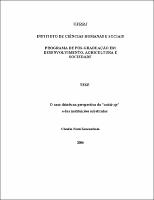Use este identificador para citar ou linkar para este item:
http://rima110.im.ufrrj.br:8080/jspui/handle/20.500.14407/16039Registro completo de metadados
| Campo DC | Valor | Idioma |
|---|---|---|
| dc.contributor.author | Zonenschain, Cláudia Nessi | pt_BR |
| dc.date.accessioned | 2023-12-18T17:17:46Z | - |
| dc.date.available | 2023-12-18T17:17:46Z | - |
| dc.date.issued | 2006-12-15 | |
| dc.identifier.citation | ZONENSCHAIN, Claudia Nessi. O caso chinês na perspectiva do catch-up e das instituições substitutas. 2006. 11 f. Tese (Doutorado em Ciências Sociais em Desenvolvimento, Agricultura e Sociedade) - Instituto de Ciências Humanas e Sociais, Universidade Federal Rural do Rio de Janeiro, Seropédica - RJ, 2006. | por |
| dc.identifier.uri | http://rima110.im.ufrrj.br:8080/jspui/handle/20.500.14407/16039 | - |
| dc.description.abstract | Esta tese analisa o processo de catch-up chinês a partir de uma perspectiva históricoinstitucionalista. Seguindo uma abordagem de inspiração gerschenkroniana, o objetivo é identificar algumas características únicas dessa experiência e compreender sua importância para o sucesso do catch-up. O padrão específico de transição política e econômica gradual e o perfil da atuação do Partido Comunista Chinês na condução deste processo imprimem um desenho próprio à experiência chinesa. São condicionados por uma história e por instituições específicas e dão origem a arranjos institucionais sem precedente histórico. A enorme dimensão da China, a diversidade entre regiões e a impossibilidade de controlar e coordenar todas as ações econômicas, junto a outros elementos importantes que caracterizam o ambiente em que as empresas chinesas estão inseridas (inclusive aqueles que decorrem da ação deliberada do Estado-Partido) criam um campo fértil para a realização de experimentações e para o surgimento de iniciativas criativas e inovadoras que são rapidamente difundidas, dando ensejo ao desenvolvimento de indústrias complexas e com níveis crescentes de produtividade e de autonomia tecnológica. A tese está organizada em três artigos que são, em parte, independentes entre si. Por outro lado, são complementares, na medida em que os temas dos dois primeiros constituem referencial analítico para a abordagem do terceiro. O primeiro artigo trata do marco conceitual histórico-institucionalista. No segundo são discutidos e contrastados os conceitos de catch-up e de convergência. O terceiro artigo examina a experiência chinesa de catch-up. | por |
| dc.format | application/pdf | por |
| dc.language | por | por |
| dc.publisher | Universidade Federal Rural do Rio de Janeiro | por |
| dc.rights | Acesso Aberto | por |
| dc.subject | China | por |
| dc.subject | catch-up | por |
| dc.subject | instituições | por |
| dc.subject | Institutions | eng |
| dc.title | O caso chinês na perspectiva do catch-up e das instituições substitutas | por |
| dc.title.alternative | The chinese case under the catch-up and the substitute institutions perspective | eng |
| dc.type | Tese | por |
| dc.description.abstractOther | This thesis analyses the Chinese catch-up process from an institutional-historical perspective. It follows a gerschenkronian inspired approach and its purpose is to identify some of the unique characteristics of this experience and the understanding of its importance for the success of the catch-up. The specific pattern of gradual political and economic transition and the acting profile of the Chinese Communist Party in leading the process render a particular design to the Chinese experience. They are subject to specific history and institutions and give rise to institutional arrangements unprecedented in history. The huge dimensions of China, the diversity among regions and the impossibility of controlling and coordinating all the economic actions, together with other important elements which characterize the environment in which the Chinese enterprises are inserted (including those which derive from a deliberate action by the Party-State) create a fertile field for the accomplishment of experiments and the raising of innovating and creative initiatives which are rapidly spread, giving place to the development of complex industries with increasing levels of productivity and technological autonomy. The thesis is comprised of three articles which are, to some extent, independent in themselves. On the other hand, they are complementary to the effect that the subject of the two first ones constitutes a conceptual reference to the approach of the third article. The first article deals with the institutional-historical framework. The second one brings forth discussions and contrasts regarding concepts of catch-up and convergence. The third article deals with the Chinese catch-up experience. | eng |
| dc.contributor.advisor1 | Castro, Antonio Barros de | pt_BR |
| dc.contributor.advisor1ID | 029.505.457-34 | por |
| dc.contributor.advisor1Lattes | http://buscatextual.cnpq.br/buscatextual/visualizacv.do?id=K4792653Y7 | por |
| dc.creator.ID | 958.229.337-34 | por |
| dc.creator.Lattes | http://buscatextual.cnpq.br/buscatextual/visualizacv.do?id=K4782977P1 | por |
| dc.publisher.country | Brasil | por |
| dc.publisher.department | Instituto de Ciências Humanas e Sociais | por |
| dc.publisher.initials | UFRRJ | por |
| dc.publisher.program | Programa de Pós-Graduação em Ciências Sociais em Desenvolvimento, Agricultura e Sociedade | por |
| dc.subject.cnpq | Economia | por |
| dc.thumbnail.url | https://tede.ufrrj.br/retrieve/30749/2006%20-%20Claudia%20Nessi%20Zonenschain.pdf.jpg | * |
| dc.thumbnail.url | https://tede.ufrrj.br/retrieve/37127/2006%20-%20Claudia%20Nessi%20Zonenschain.pdf.jpg | * |
| dc.thumbnail.url | https://tede.ufrrj.br/retrieve/43511/2006%20-%20Claudia%20Nessi%20Zonenschain.pdf.jpg | * |
| dc.thumbnail.url | https://tede.ufrrj.br/retrieve/49901/2006%20-%20Claudia%20Nessi%20Zonenschain.pdf.jpg | * |
| dc.thumbnail.url | https://tede.ufrrj.br/retrieve/56375/2006%20-%20Claudia%20Nessi%20Zonenschain.pdf.jpg | * |
| dc.originais.uri | https://tede.ufrrj.br/jspui/handle/tede/680 | |
| Aparece nas coleções: | Doutorado em Ciências Sociais em Desenvolvimento, Agricultura e Sociedade | |
Se for cadastrado no RIMA, poderá receber informações por email.
Se ainda não tem uma conta, cadastre-se aqui!
Arquivos associados a este item:
| Arquivo | Descrição | Tamanho | Formato | |
|---|---|---|---|---|
| 2006 - Claudia Nessi Zonenschain.pdf | 2.27 MB | Adobe PDF |  Abrir |
Os itens no repositório estão protegidos por copyright, com todos os direitos reservados, salvo quando é indicado o contrário.

